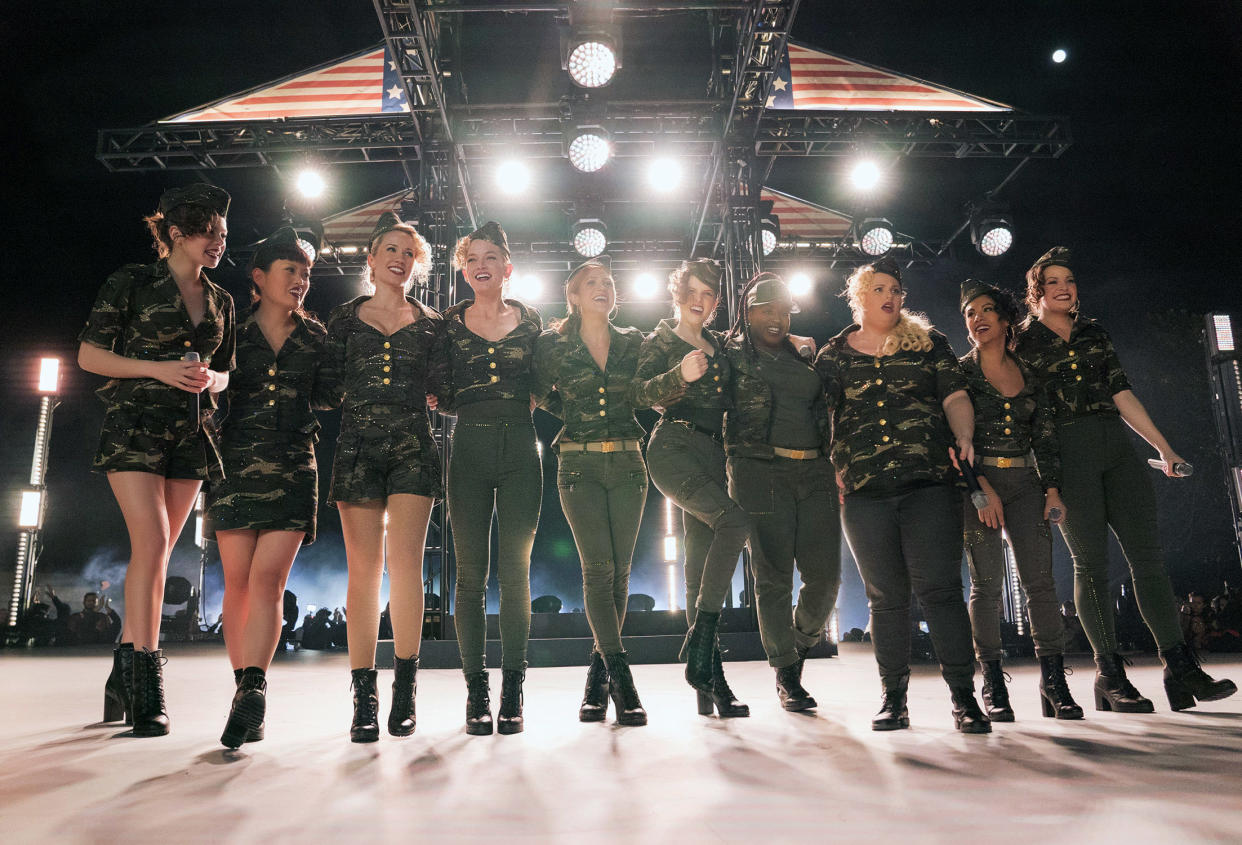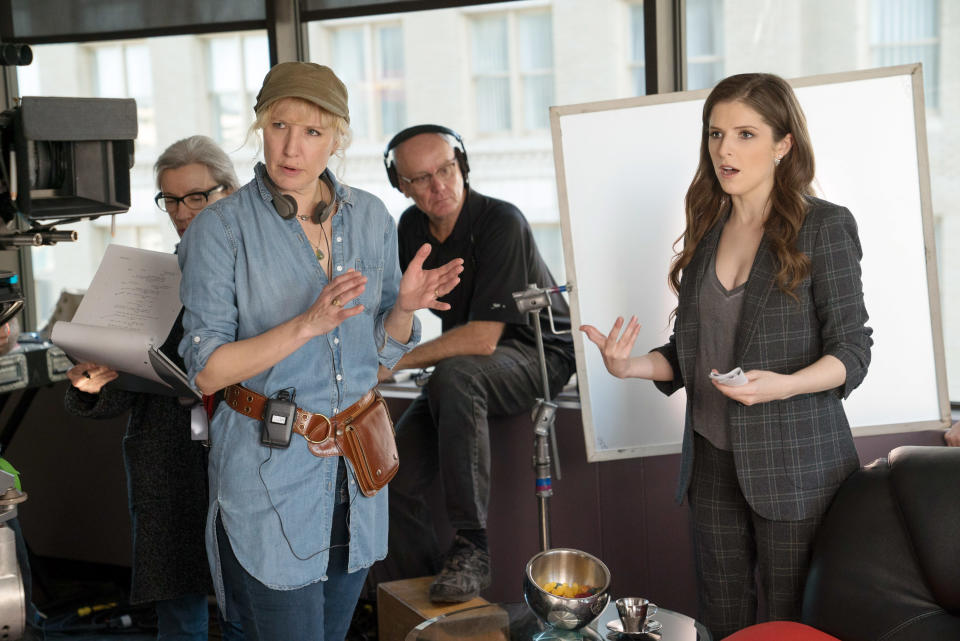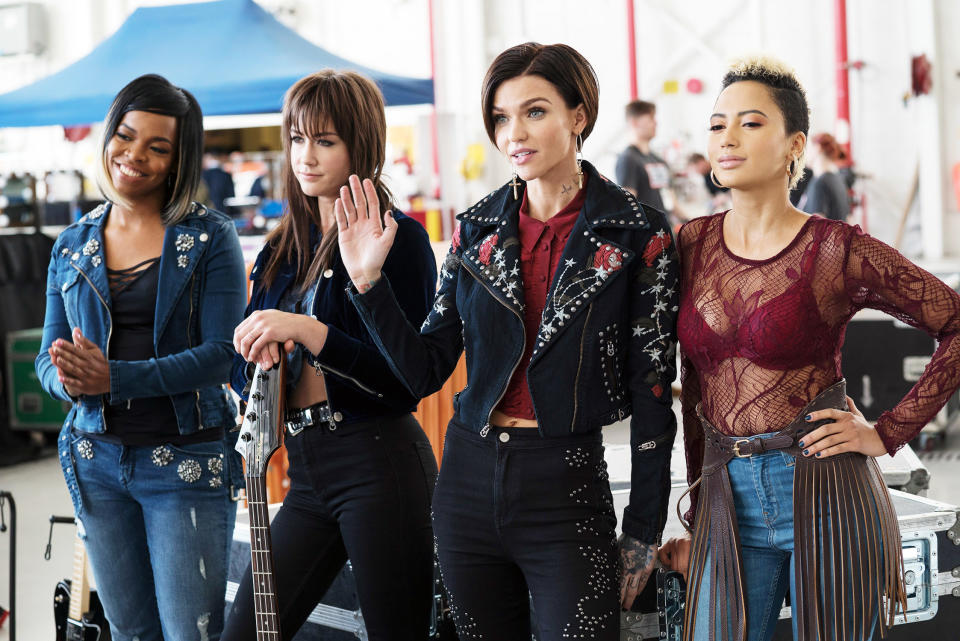Inside the Bellas' final riff-off in 'Pitch Perfect 3': An aca-oral history

When the Barden Bellas assembled in an empty swimming pool late one night for a four-way riff battle against their fellow Barden University a capella groups, few suspected that a new cinematic tradition was being born. But the “riff-off” — a kind of round-robin tournament where competitors strive to seamlessly transition between songs while staying on beat and within a given musical category — has since become a staple of the Pitch Perfect franchise, with each new installment trying to top the last. “It’s such a surprise that it’s become something people really respond to,” marvels Anna Camp, who has frequently competed in the riff-offs as the Bella’s uptight co-leader, Aubrey Posen. “People love a good competition, so I’m not really surprised now, but looking back, I had no idea that they were going to love these moments so much.”
The franchise’s latest — and last — chapter, Pitch Perfect 3, brings that tradition to a close in memorable fashion. Unlike the riff-offs seen and heard in Pitch Perfect and Pitch Perfect 2, the grand finale incorporates instruments into the musical mix. Having pulled strings with Aubrey’s military officer father to nab the Bellas a slot on a USO tour, the singers have an uncomfortable meet-and-greet with their fellow performers, including the rockabilly outfit Saddle Up (played by real-life band Whiskey Shivers) and a set of all-female rockers, Evermoist, fronted by the ultra-intimidating Calamity (Ruby Rose). Eager to prove themselves, the Bellas propose a good old-fashioned riff-off only to see the musical tide quickly turn against them as the track list jumps around from contemporary pop hits like “Shut Up and Dance” to a country-fied take on “Wake Me Up.” We spoke with stars Camp and Hailee Steinfeld, as well as Pitch Perfect 3 director Trish Sie, to assemble this oral history of the Bellas final riff-off.
Trish Sie: I’m a musician, and I come from a world of people that play instruments, so it was really fun to imagine a capella nerds up against musicians with amps, mics, drums kits, and even DJ equipment. Weaving those two together was tricky because we wanted the Bellas to be overwhelmed both emotionally and literally sound-wise, but they still have to shine. They’re still our girls, and we want them to sound really awesome, even though they’re getting outplayed. The other thing we wanted to do with this one is, once the musicians start playing their instruments, not just segue from one song into another, but actually have them mash up the songs in a way so that the chord progressions match. That way, when they finally get up onto the stage, they’re not just passing the song around.
Hailee Steinfeld: It’s fascinating how the arrangements of the riff-offs come together, and this one was especially fun because we’re working with so many people. Ruby Rose is an incredible singer and, of course, we’re competing against instruments as well. So the Bellas try their hardest to think on their toes, but they sort of can’t compete at this point.
Anna Camp: A riff-off is incredibly hard to do in real life, and that’s why we make it look really easy in the movies — because it’s something magical and special. There’s so many rules, that we are very lucky to have it all mapped out for us before we get there so we don’t have to come up with any of that singing or any of those songs directly on the spot.
Sie: With the song selection, we wanted to do a kind of panorama and show a lot of different eras and a lot of different genres. In the past, we’ve found that you want strong connections between the songs so it doesn’t feel completely gratuitous. So I was very, very committed to linking the songs lyrically: end one song on this word, start the next song on the same word, and to have them kind of fit into categories where you don’t have to stop and think too hard about it. It should feel obvious that these songs are all in the same category. So we consider all of those things and, in terms of dividing up the parts, our music supervisors and arrangers are really good at knowing these women’s voices and who’s gonna sound good singing what.

Camp: I was not included in any of the discussions as to picking the songs. None of the actors have a say in what songs we’re going to sing. But I do know that it was going to be a riff-off like we’ve never had before, because the other bands are using musical instruments. We’re not quite sure why everyone else is getting along and just having a jam session. Hopefully, they learn the lesson that a riff-off should be about enjoying yourself as you’re singing and not just a competition. Of course, my character, Aubrey, is obviously the most competitive out of all of them! So I don’t know that she necessarily learns that in that moment.
Steinfeld: I wish I could have sung all of it! I’m just as great a fan of the songs that we’re singing and have a love for singing in general. I see these arrangements and I’m like, “Oh my God,” and then I’ll get stuck with the bass note or some sound that you hear. The funny part is, after having made these movies, any song I hear that we’ve done in the films, I’ll sing my part. Like I’ll be in the car with my friends, “Toxic” will come on the radio, and I’ll start singing that weird synth noise you hear at the back. Everybody’s like, “Wait, how do you pick up on that?”
Sie: I tried to work Alphaville in there for a while, but nobody would know who they were. I definitely tryied to get some Aerosmith as well, but it just didn’t work out. Everything else cleared fairly easily, I think. Thankfully, it’s not my job to have to do that, but it is interesting how some songs end up being price-prohibitive, while others aren’t. And some songs have samples in them, which makes it a whole different ballgame. Music licensing is complicated!
Camp: I was happy that I got to sing “Shut Up and Dance.” I feel like it’s a very Aubrey moment and kind of a throwback to the riff-off in the first Pitch Perfect when she sings, “Hit Me with Your Best Shot.” It’s very much in Aubrey’s wheelhouse: cute, funny, and a little cheesy, which is always good for her. And I was pitch perfect. Pun intended.
Sie: Whiskey Shivers did the hillbilly version of “Wake Me Up” and they can make any song sound great. The irony of having a decidedly not bluegrass-y song rendered in a bluegrass way was funny. We thought it was funny to counterprogram like that a little bit, like having the military guys sing Beyoncé. The band prerecorded the song and then played along to it, because the room was very echoey, and the production equipment made a lot of noise.
Steinfeld: Before shooting, we’ll always do a pass so we can hear each other doing our parts. It’s very easy to learn and record your own part, but then it comes on and you instinctually sing the lead vocal because you’re familiar with the song, when you’re supposed to just sing the melody. So it’s helpful to vocally mark it live, and then we do it all to a pre-recorded track.
Sie: One of the reasons we can’t record the riff-off live is because other people are talking over it and interjecting. You don’t want to hear muddy music over someone talking, or if you decide to put a line in a slightly different place and it doesn’t work out timing-wise and you hear echoes of the music. So sometimes we’d have Rebel Wilson saying her lines, and the people who were singing had to wear earbuds listening to the track and pantomime the whole thing, not making any noise on the guitars or any noise out of their mouths so we could hear her dialogue really clearly. And it’s really tricky for guitarists not to play the guitar! There’s also something so eerie about the room being silent; you see the band and it looks like they’re singing their asses off, but it’s absolutely silent so that we can have the characters saying their lines.
Camp: There’s a line that I improvised that got in, where Aubrey says that the bands have disqualified themselves because they’re using musical instruments. That was not scripted, so I’m glad it made it in!
Sie: Anna Camp improvised so many good lines that I wish I could have used. Like my favorite line possibly in the whole movie is Anna saying, “That’s a guitar, man.” It’s just plain ridiculous! So she improvised all kinds of stuff in that scene. They all did. The funniest Bella reactions were the ones that they threw out off the cuff.
Steinfeld: The sequence took about a week. A day or two in, we’re thinking, “This is so cool that we get to call this work.” We’re singing, we’re dancing, and we’re making fools of ourselves and it’s awesome. But then, three days in, we’re like, “OK, I’d like to move on to something new,” and by the fourth day, we’re going, “This is crazy that we’re still doing this.” But whatever it takes, you know?
Camp: The riff-offs are always really long because there are so many groups that you have to focus on. Here, we had to get so many angles with Ruby Rose’s band, Evermoist, as well as the Saddle Up crew and the rappers. We filmed a lot of the performances on real Air Force bases and had audiences with thousands of extras. It became a real performance, so we’d always want to see each other’s progress, watching from the sidelines and rooting everyone on even though we’re supposed to be in competition in the film.
Sie: That hangar was a really beautiful location, and I thought it was really fun to do a complete 360 with the Steadicam a couple of times. We called that our “Prove it” shot, meaning that we wanted to prove that all these people were in the room at the same time playing instruments. We wanted the audience to feel like a fly on the wall circling this event as it was taking place. I also felt it was really important to show little details like the Evermoist drummer, Venzella Joy, playing her sticks on the traveling road case. I felt those quirky details of people showing their musicality and eccentricities would put the Bellas back on their heels a little bit. Like, “Whoa, these guys are really comfortable in their own skin and really good at what they do.” In between takes, these bands could not contain themselves! They’d grab each other’s instruments and just start playing. So it seemed like an easy way to make the Bellas feel completely adrift.
Steinfeld: What’s so incredible about a cappella is that if you aren’t paying extremely close attention, sometimes you could be mistaken by the fact that there are no instruments involved. It’s cool that the Bellas keep up as long as they can and sound equally as beautiful as the instruments. Obviously, it throws them for a loop in terms of making them feel like they can’t do certain things, but they do quite a bit in terms of using their voices to fill in for what instruments do.

Sie: That scene went through a ton of iterations [in the editing room]. We did it in chunks, then test it and come back to it. We spent three full days trying things out because the actors do ad-lib a lot, so we tried to find the best combination of jokes. There used to be more dialogue in between the rounds, but that felt like it slowed it down; you want to give the characters enough time to interact without the pace dragging. Same with the music: sometimes things repeat too much and you need to cut some of it out or give it space to breathe. It took a lot of trial and error to give it its flow.
Camp: I’m extremely happy with where Aubrey ends up as a character at the end of the movie. I loved the arc that she just had in the first film where you see that she’s not going to compete against the other women — she’s going to compete with them as a team. That’s why she’s way more fun to hang out with in the third movie. I’m excited to think about what would happen to her after this film. I hope she does become a doula, like what she says in the end, and goes and has some sort of spiritual awakening. I do think that you’ll never be able to get the competition out of her, though. She’ll probably have a competition about who can be the most relaxed doula or something like that.
Steinfeld: I think Emily has gone from having to prove herself and please her idols to being a little cooler and more established. She has a place in the group now. The girls have accepted her, even though they still give her a hard time because she’s the youngest one and still has a lot to learn and a long way to go. But she’s in it now.
Sie: First and foremost, I wanted the audience to come out of that movie liking these characters and believing that, even as absurd as it all is, they feel real to you. That was my biggest sounding rod throughout the whole thing. And then I just want to bring a smile to people’s faces. It’s the holiday season, and the world is going through some rough stuff right now, so I think everyone needs 88 minutes of smiling, laughing, seeing people be good to each other and hearing some good music. It’s a positive thing, you know? This movie’s not going to cure cancer or bring world peace, but I hope that people come out feeling a little better than when they went in.
Pitch Perfect 3 is playing in theaters now.
Watch the Pitch Perfect 3 cast on how hard it was to say goodbye:
Read more from Yahoo Entertainment:


